The best place to see rock art in the United States is the American Southwest. The canyons punctuating the Colorado and Utah borders may seem empty, but there lies the mystery. This area was a center of population, and those who lived here told their stories on walls. To the east is the Colorado National Monument, and to the west is that marvel, Arches National Park. In between, quiet as a secret, the undesignated space is filled with those who went before.
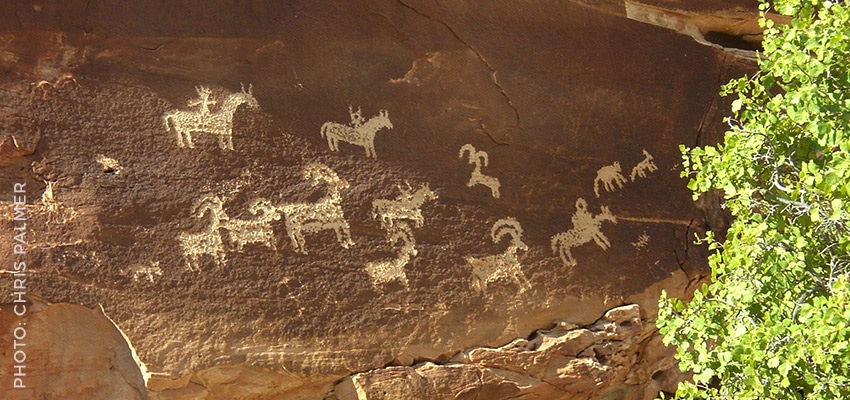
Rock art that’s been chipped, pecked, or etched into the surface of a rock, probably with quartz, is called a petroglyph. Art, painted on a flat rock surface, is called a pictograph. Mixing local minerals, and combining them with oils, gave long-ago people colored pigments to paint with. We believe their brushes were made from yucca and animal hair.
The best examples of pictographs are deep in underground caves. Wiggle into one of these caves on your belly. You have never experienced such total and absolute darkness. Eventually, the world opens up, and you are able to stand. And there, on dim walls, are massive, magnificent animals, hunters, and images of childbirth. The black and red dyes are still vivid.
We believe these caves, which feel like going through the birth canal, were used to enhance magical thinking for successful hunts, to honor the spirit of animals, and to acknowledge the power of birth.
Some rock art in the Southwest’s canyon country is several thousand years old, made by people of the Mesquite Flat Culture, from 3,000 BC to 1 AD. Most rock art was created by people from the Fremont and Anasazi cultures—they lived from 600 AD to 1,200 AD. This marks those who made this art as being ancient. Imagine this: Rock art with the same symbols is seen in Australia and was created 60,000 years ago.
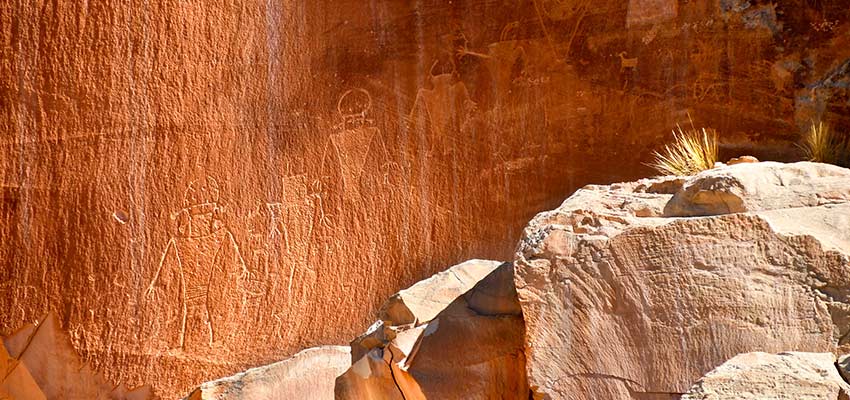
Some people, in the vast and quiet desert, believe they have seen Kokopelli dance across a wall, carrying his bag of lusty seeds. We don’t know what all the symbols mean. We do know that hunter-gatherers who lived then had a harsh existence, straddling the edge between life and death. They didn’t have time to make fanciful doodles.
The images may represent conversations with the spirit world, recount stories, record events, or mark trails, territorial boundaries, or locations where water could be found. We ask Indigenous people, alive now, what these symbols mean. They agree that the spiral, vibrating in every part of the globe, is a symbol of energy.
The meaning of animals and arrows is clear, and it’s not surprising that so many of the figures are of animals. A good hunt meant the difference between a starving winter and food to store away until spring thaw. The animals are so important, they seem mythic. One of the most common figures in Southwestern rock art is a human being.
Discovering Rock Art Sites in the Southwest
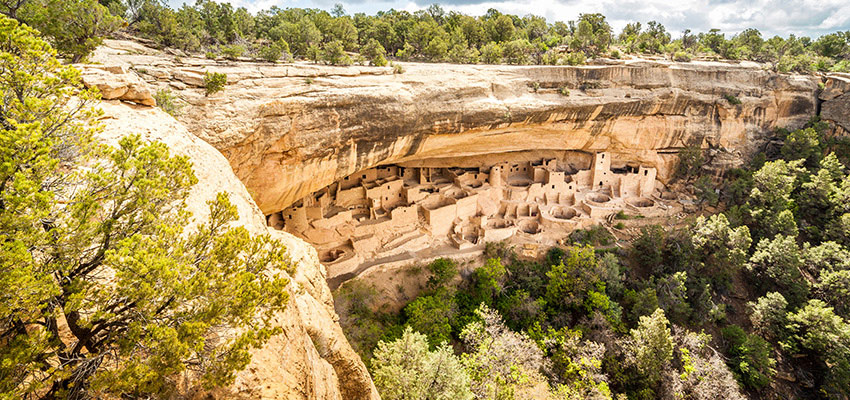
In Utah, you’ll find rock art in Arches National Park, Canyonlands National Park (and other sites near Moab), along the San Juan River across from the Navajo Reservation, in the Glen Canyon Park, and in Zion. Rock art appears in Colorado in Mesa Verde and Colorado National Monument. In Arizona, you’ll find it in Canyon de Chelly, Navajo National Monument and the Petrified Forest. New Mexico’s Bandelier National Monument, Chaco Canyon (Chaco was the Rome of the Anasazi people), Petroglyph National Monument, and Three Rivers Monument all offer up their wonders.
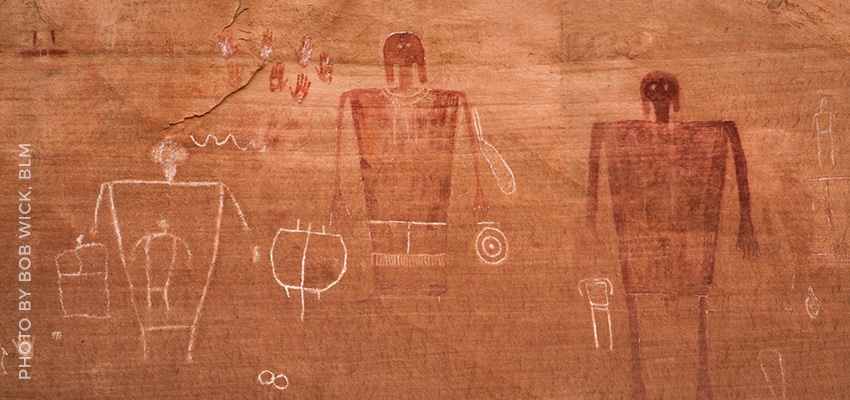
We suggest Indian Creek Corridor, about 50 miles south of Moab, UT. There you’ll find Newspaper Rock in the Bears Ears National Monument. This extraordinary art blazes with life. On a large, nearly flat, sandstone people chose to extravagantly carve their hopes, fears, and wishes. Newspaper Rock is a Utah State Monument and is also listed on the National Register of Historic Places.
Navajos call it Tse Hane, “the rock that tells a story.” Located in a deep canyon near a permanent spring and running stream, this spot attracted many cultures for 2,000 years. The images on Newspaper Rock are said to have been made by the Archaic, Basketmaker, Anasazi, Fremont, and contemporary Pueblo cultures. There are also images from the historic period, including creations by Utes, Navajos, and European Americans. The presence of horses and riders indicate some were made after the Spanish arrived.
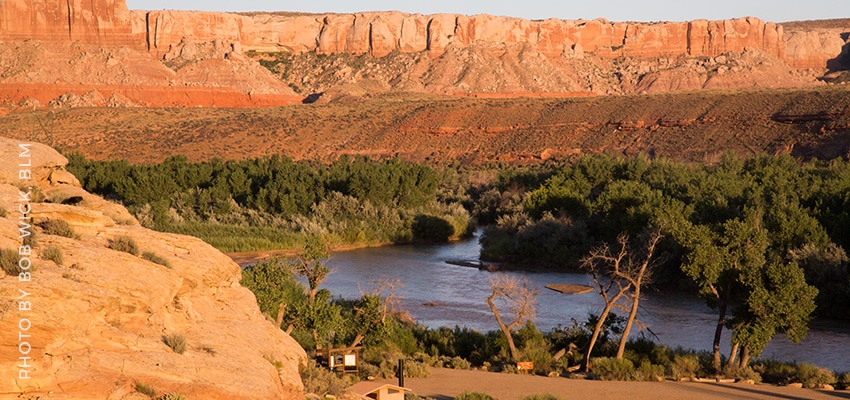
Another miracle is just one mile from the tiny, Mormon pioneer town of Bluff, UT. Hike up Cottonwood Canyon, and there are large panels of horse figures, probably carved by Ute Indians. Five miles southwest of Bluff, the vast petroglyph panel at Sand Island stretches over a quarter mile—the images range from the bottom to the top, about four stories in height.
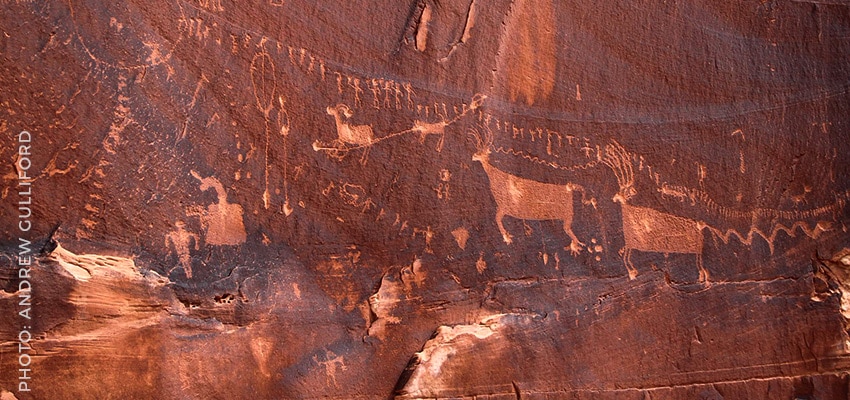
About ten miles south on Comb Ridge, “the spine of the earth,” there’s the small Wolf Man Panel and the awesome Procession Panel, with 187 tiny figures marching into a central circle. Some believe it looks as if people are climbing into a spaceship. Others think people are climbing out of a spaceship.
Academics, often from eastern universities, come up with their own translations. They miss the point. We know these ancient people—they are us. Imagine yourself living then. It feels as if some images were for magical or ceremonial purposes. Others are the prayer for a good hunt and safety of the tribe. Surely some are reflections of the artistic nature of individuals. They all say, and what we want to say: “I was here. I was alive at this place. This is what was important to me. I will be remembered.”
How to Behave with Rock Art
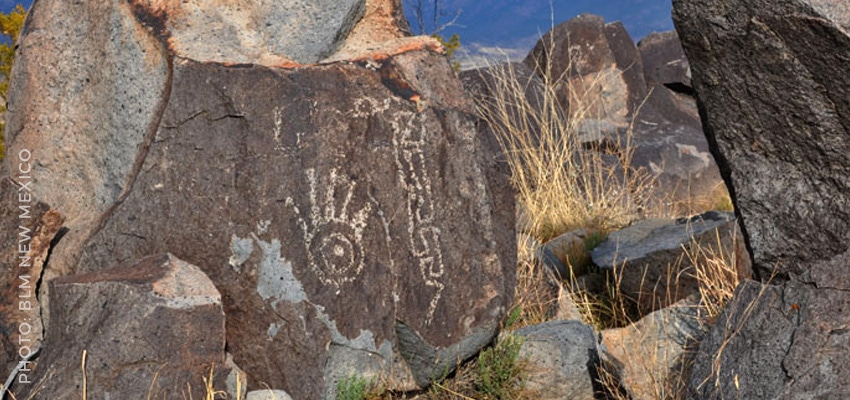
Rock art sites are fragile outdoor museums left by prehistoric man. They can be easily damaged, so:
- Treat them with them with the respect of a holy cathedral. Many Native Americans still consider these places sacred.
- Don’t use chalk, crayons, ink or paint to make the images more clear.
- Don’t make new carvings.
- Please, no molds of any kind.
- Many are on private property. Respect that.
- Don’t touch. It’s seductive to run your hands over the images, feeling connected to those who lived thousands of years before. Instead, use your imagination. The oils and acids in your hands will degrade the art.
- Bring binoculars or a camera with a telephoto lens. Some art is difficult to get to.
- Many southwestern rock art sites are home to rattlers. They warm themselves on rocks and slide into cool crevices between rocks. Watch what you use for hand holds.
Ancient drawings, carvings and paintings on rock inspire us with unbounded wonder and awe. They are a window into our past and a beautiful mystery in our present. When you visit America’s Southwest, consider making at least one pilgrimage to an area of rock art.
When you’re ready to fall into the wonder of a timeless world, let your Destination Expert know that you’d like to discover the American Southwest.









